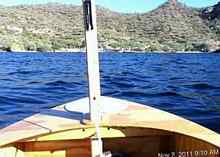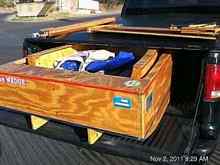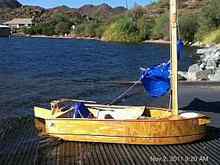
 Custom Search
|
|
| sails |
| plans |
| epoxy |
| rope/line |
| hardware |
| canoe/Kayak |
| sailmaking |
| materials |
| models |
| media |
| tools |
| gear |
 |
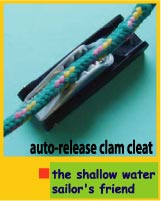 |
| join |
| home |
| indexes |
| classifieds |
| calendar |
| archives |
| about |
| links |
| Join Duckworks Get free newsletter Comment on articles CLICK HERE |
|
|
| Wedge Sail |
by Ken Simpson, Phoenix, Arizona - USA |
It's been a lengthy journey, but finally I am ready to release the plans for the WEDGE Sail option. The excessive heat this summer, and the lack of consistent wind kept me from the final testing that is so important in completing a design. As you may recall, early tests of the sail rig indicated that the boat was skittish, capable of being blown off course by heavy gusts. This was before the daggerboard design was implemented. I am pleased to say the the daggerboard has not only corrected this problem, but it has made the handling of the boat a pleasure. Rudder control is precise and effective. Wind gusts are no longer something to be feared, but rather, they just provide additional challenge to the skipper. The following pictures should provide proof of the design, and the capability of the WEDGE Sail version.
One of the many unique aspects of this design is the Tiller assembly. Because this is a small boat, width and space to move around is limited. So, instead of the pilot having to shift position to steer the boat, the Tiller flips from one side to the other, and the end result is the same; effortless steering. The Rudder is of the kick-up type, and has two lines that aid in raising or lowering it to the water. A big aid when launching and beaching. True to it's portable boat roots, all the components of the WEDGE Sail fit into the covered bed of a small pickup truck, my Chevy S10. The hull modules above can be seen toward the front, with seat and rudder laying flat behind. The mast and boom are on the left side of the hull. Yes, it all fits with the gate closed.
This is the wonderful Daggerboard. I say that because it's use literally turned the WEDGE into a safe, reliable sailboat. Without it the boat was a wanderer. Now it is capable and fun! You will note the 1/2 inch plywood has it's edges glassed for strength and to prevent water penetration. It would be even stronger if the entire daggerboard were fiberglass sheathed.
The housing is glassed on the bottom of the hull, and completely waterproofed prior to installation. The forward seat was cut in half to allow placement adjacent to the housing. The seat supports are evident in the photo.
Setting up a boat is always a chore. With the WEDGE Sail, I tried to make things as simple as possible. The Mast and Boom fold in half for storage, and are easy to unfold while on the boat. There are no shrouds to contend with. When the sail is down (as shown), the boom is held up by a boom-line. The halyard runs up the mast, through eyes, so raising and lowering the sail is an easy task. Velcro straps should be used to secure the lowered sail to the boom.
One of the elements of sailing that requires personal adjustment is the heeling of the boat. Some well designed boats heel just enough to make it pleasurable, others go to extremes and scare the heck out of you. Although this is a flat bottomed boat, it seems to behave well, and with the addition of the much needed daggerboard, excessive heeling can be sensed and the necessary corrections can be taken (let the sheet out, turn gradually) to prevent capsizing. Launching is also an easy process. Shove off, get in, paddle out, lower the rudder, lower and lock the daggerboard, and raise the sail. The poly-sail will fill nicely. If heavy winds are expected, a center tie should be used to hold the sail to the mast. Otherwise, it is a 3 point attachment, and works well with such a small sail. The joint of the folding mast can also be seen, and it is strong and true, because the two halves are bolted together for security.
Back on the launch ramp, I inspect everything, to insure nothing broke or gave way. The daggerboard is resting inside the hull, and all looks well. I allowed the rudder to kick up naturally, without any damage. The sail must be Velcro strapped to the boom when down, so that one can easily paddle into shore, without it blowing in their face. I have to say that sailing the WEDGE is a fun, safe, exciting yet demanding experience.
Rough water can always be trying in a small boat, especially a sailboat. Not anxious enough dealing with changing wind conditions, but now with choppy waters, just adds to the overall sailing experience. But that's what it is all about, isn't it ? One thing I noticed, the boat is more stable in these conditions when sailing, rather than motoring. That is because the combination of sail, rudder and daggerboard all contribute to a balance of forces not found in a motorboat.
Nearly ready for the trip back home, it is a good time to reflect on the day's activity. Good wind, warm weather, and a capable boat all add up to what the home boat builder is all about. There is great pleasure to be had in this hobby, and the kind remarks made by casual onlookers merely amplifies that feeling. The WEDGE Sail is a good example of this. Easy to build, transport and rig. It doesn't get much better! Ken's plans are on Duckworks. |
 |
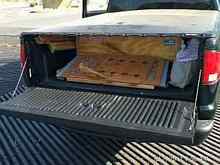
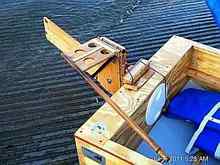
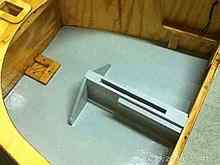 This is a view of the modified forward module, showing the addition of the Daggerboard Housing, with the mast step and deck support forward.
This is a view of the modified forward module, showing the addition of the Daggerboard Housing, with the mast step and deck support forward.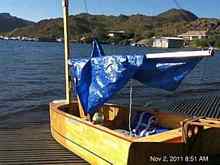
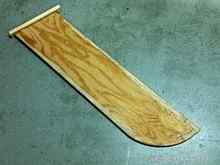
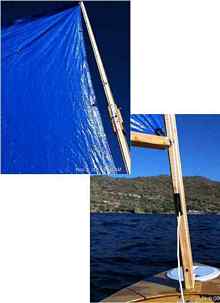 The photo at right was taken in winds of about 10 mph, a good indicator of the WEDGE Sail's ability.
The photo at right was taken in winds of about 10 mph, a good indicator of the WEDGE Sail's ability.